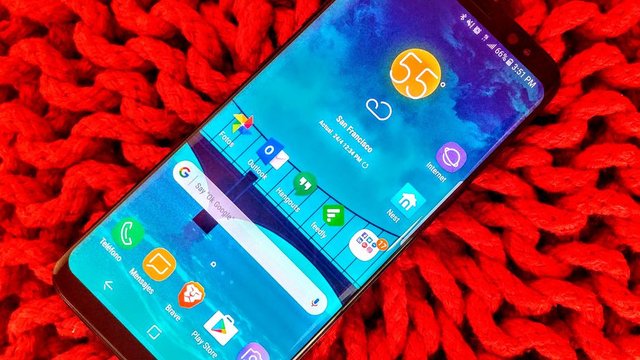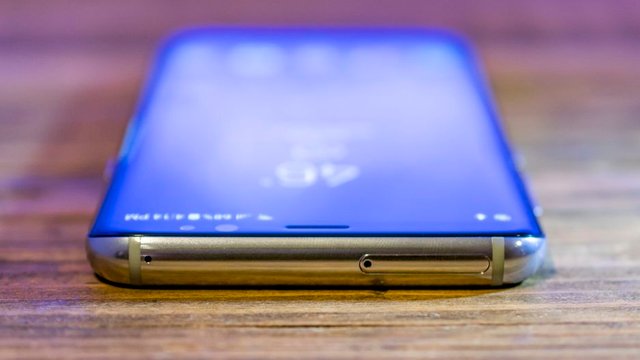Advantages of the Samsung Galaxy S8 Plus and comparisons with other phones

Samsung Galaxy S8 Plus: Features and specifications
Display: 6.2 inches with an aspect ratio of 18.5: 9
Resolution: 2,960x1,440 pixels
Processor: Snapdragon 835 eight-core (four 2.35GHz and four 1.9Ghz) or Exynos 8895 eight-core (four 2.3GHz and four 1.7Ghz) with the new manufacturing process of 10nm
RAM: 4GB
Storage: 64GB
MicroSD slot: Yes, up to 2TB
3,500mAh battery
Rear camera: 12 megapixels with aperture f / 1.7, optical image stabilization and double pixel
Front camera: 8 megapixels with autofocus and face detection
Operating system: Android Nougat
Connectivity: Bluetooth 5.0, Wi-Fi 802.11ac, NFC, LTE Cat. 16
Water resistant: Yes (up to 1.5 meters deep for 30 minutes)
Iris reader: Yes
Wireless charging: Yes
Fast charging: Quick Charge 2.0 with Samsung's Adaptive Charging technology
Hearing aids included: Yes, some optimized by AKG, company of Harman (recently acquired by Samsung)
Other features: USB-C, Samsung Pay and Android Pay, the screen detects the pressure that the user places at the bottom (Start button), Bixby (with dedicated button), Google Now, Google Assistant, heart rate sensor, It can be converted into a desktop computer with Samsung DeX.
Size: 159.5x73.4x8.1mm
Weight: 173 grams
How much does it cost Samsung to manufacture the Galaxy S8? and the Note 8 is on its way
by Juan Garzon
02:47
Large play-pause toggleAUTOPLAYONOFF00: 0002: 39
Differences between the Galaxy S8 Plus and Galaxy S8
Your screen is bigger: 6.2 inches vs. 5.8 inches.
Larger size: 159.5x73.4mm vs. 148.9x68.1mm.
Larger capacity battery: 3,500mAh vs. 3,000mAh.
Heavier: 173 vs. 152 grams.
Thicker: 8.1 vs. 8mm.
It is more expensive.
Your fingerprint reader is harder to reach with just one hand.
Design comparison: Galaxy S8 Plus vs. S8 vs. LG G6 vs. Google Pixel XL vs. iPhone 7 Plus
Galaxy S8 Plus Samsung Galaxy S8 LG G6 Google Pixel XL iPhone 7 Plus
Screen 6.2 inches 5.8 inches 5.7 inches 5.5 inches 5.5 inches
Size 159.5X73.4X8.1mm 148.9X68.1X8mm 148.9x71.9x7.9mm 154.7x75.7x8.5mm 158.2x77.9x7.3mm
Weight 173 grams 152 grams 163 grams 168 grams 188 grams
Although it is clear that the Galaxy S8 Plus has an Edge screen (and brings its functions), but the curvature of the screen is less than that had the Galaxy S7 Edge.
This means that the Android phone no longer gives the feeling of having a screen "rolled" inside itself, but still allows the content to be more immersive than in a cell phone with flat screen.
This change seems good, since it allows the cell phone to be more symmetrical, feel better in the hand, help reduce the problems that our fingers can cause when blocking the screen or activate functions "without wanting to" and that the frame of Metal feels less when you hold it.

https://www.cnet.com/es/videos/galaxy-s8-de-cerca-con-el-diseno-del-celular-sin-bordes/
However, Samsung had to make some sacrifices to achieve this design: it removed the capacitive buttons and the physical front panel; the fingerprint reader is now located in the back.
The capacitive and physical buttons, which were used to perform the basic functions of Android navigation and to turn on and unlock the cell phone are no longer present.
On this occasion, Samsung integrated buttons that are now virtual (on the screen through software) in the Galaxy S8 Plus and the Start button (central), the screen can detect the pressure
For its part, the fingerprint reader now went from being integrated in the physical Start button to being in the back.
This cell phone brings the new USB-C port with Quick Charge 2.0 quick charge, a 3.5mm headphone jack, a speaker, microSD card slot, heart rate sensor and the new button dedicated to Bixby, the new virtual assistant the company (more information on this later).
The Galaxy S8 Plus keeps the front and back glass, while its edge is still metal
https://www.cnet.com/es/videos/galaxy-s9-plus-vs-galaxy-s8-plus-cuales-son-las-diferencias/
Android Nougat, Bixby, Samsung DeX and more
software
Galaxy S8 Plus Samsung Galaxy S8 LG G6 Google Pixel XL iPhone 7 Plus
Android operating system Nougat Android Nougat Android Nougat Android Nougat iOS 10
The Galaxy S8 Plus runs Android Nougat with the custom interface of the company that looks a lot like the one that integrated the Note 7, which is a good thing.
This means that the interface gives priority to the white background in the settings and notifications, in the quick adjustments it combines them with the blue color and in the configurations the icons are of different colors, but they are organized in specific categories, similar to what Google offers in Android Or, within the configurations you also find the options to be able to change the resolution and the option to place the blue light filter (night mode).
On the other hand, the Galaxy S8 Plus integrates Google Assistant and Google Now, but also the new virtual assistant of the company: Bixby.
In general, Bixby is composed of three parts: voice recognition, Hello Bixby panel (or Bixby Home) and recognition of objects and places (Bixby Vision).
Speech recognition allows you, for example, to ask Bixby to turn on your cell phone's blue light filter; you can ask him to find pictures you took during your vacation in Hawaii; that you zoom in on that photo, that you simply rotate it or that you can place it as a wallpaper with just using your voice.
In addition, with a single voice command you can ask Bixby to play a video you recorded during the holidays, directly on the TV in your living room.
For its part, Hello Bixby, located in the left panel of the Home screen of Samsung Galaxy S8 works very similar to Google Now.
https://www.cnet.com/es/videos/bixby-este-es-el-asistente-virtual-del-galaxy-s8/
This panel integrates basic information such as weather, video recommendations and your physical activity, but unlike Google Now, Bixby can integrate information from apps like Facebook, Spotify and Twitter, and help you customize that screen. Bixby also learns from your behavior to suggest different things (make calls at a certain time or similar).
Samsung DeX: Your cell phone as a desktop computer
Samsung DeX is a stand or dock that allows you to use your Galaxy S8 Plus as the CPU of a desktop computer.
You only have to connect the Galaxy S8 Plus to Samsung DeX and from there to a monitor so that the Android interface is transformed to the appearance of a desktop computer operating system
https://www.cnet.com/es/videos/samsung-dex-usa-el-galaxy-s8-como-computadora-de-escritorio/
Other features or innovations of the Galaxy S8 Plus
You can change the order of the navigation buttons and customize their background color.
You can divide the sound that plays different apps to a speaker or Bluetooth.
You can play sound simultaneously on two devices with Bluetooth (headphones, horn, etc.).
It has a one-hand mode that you can activate with a gesture (by sliding from the corner) or by pressing the Start button (three times).
It has equalizer.
It has climber to UHQ sound.
Integrate the game launcher (Game Launcher) to optimize the experience or bring different functions.
The fingerprint reader can be used to open or close the notification panel.
You can set the volume limit with a PIN.
The screen always on (Always On Display) can now integrate different widgets.
You can completely remove the app drawer (iPhone style or Xiaomi interface) or restore its icon to Start.
Google Play Music allows you to store up to 100,000 songs in the cloud (50,000 is the limit regularly) and offers you three months of subscription service testing.
You can activate the camera by pressing the power button twice
Performance: There is not much to complain about
Specs comparison: Galaxy S8 Plus with other phones
Galaxy S8 Plus; Processor
2.35GHz Qualcomm Snapdragon 835 (eight cores) / 2.3GHz Samsung Exynos 8895 (eight cores)
4GB RAM
64GB storage
The Galaxy S8 Plus brings the Snapdragon 835 processor or eight-core Exynos 8895 (depending on the market), processors that integrate the new 10nm manufacturing process that promises great benefits.
In everyday use, this Galaxy S8 Plus phone is very fluid, even when you have many apps running at the same time. Navigating the screens and menus and opening apps is something that is achieved without problems; the same when you use it to play video games like FIFA Mobile and NBA Live.
Said the above, I think Samsung could reduce a bit the duration of some animations to offer an even more fluid experience and it seems that searches within the app drawer is not the best implemented and is the slowest part I found on the cell phone
Link: https://www.cnet.com/es/videos/galaxy-s8-de-cerca-con-el-diseno-del-celular-sin-bordes/
Congratulations @eliasjo! You have completed some achievement on Steemit and have been rewarded with new badge(s) :
Click on the badge to view your Board of Honor.
If you no longer want to receive notifications, reply to this comment with the word
STOPDo not miss the last post from @steemitboard!
Participate in the SteemitBoard World Cup Contest!
Collect World Cup badges and win free SBD
Support the Gold Sponsors of the contest: @good-karma and @lukestokes
for real? I hope it helps you